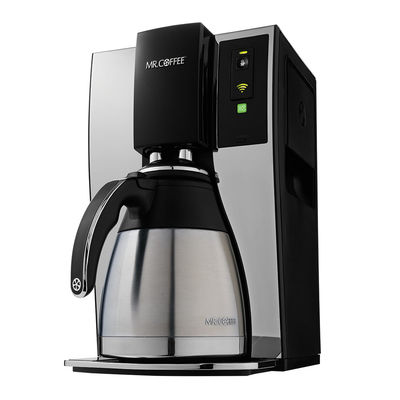M2M Insider: M2M and IoT News, Trends and Analysis
- Written by Bill Gerba
- Published: 18 February 2015

As much as we love to see all manner of devices being connected to the burgeoning Internet of Things, sometime sthey just don't make a lot of sense. That certainly seems to be the case with this WiFi-connected coffee maker that Engadget recently reviewed. To wit, they noted that:
Overall, remote controls and some handy reminders may not be enough to justify the Smart Coffeemaker's $250 asking price, though it's currently seeing discounts down to about $150 -- roughly $60 more than its non-WiFi stablemate. Still, I don't see myself paying that much to get my drip coffeemaker hooked into the Internet of Things. If Belkin and its hardware partners can chip away at the costs involved, maybe someday choosing a WiFi model will be a no-brainer. As it stands, though, a $60 premium seems too steep for some nifty conveniences.
The hallmark of a smart device is first and foremost that it's smart -- it needs to solve some problem that its dumb counterpart simply couldn't address. While the WeMo functionality that Mr. Coffee has added to their standard line of basic coffee brewing machines has some interesting technical merits, there's just not that much you can do with a coffee marker remotely. Having a fresh pot ready when you wake up was already easily accomplished by a simple mechanical timer, and it's not like this device can grind its own beans or clean itself -- both of which are features I'd probably be willing to pay something for.
So instead what we have is a technical taste of what's to come. Mr. Coffee can start acquiring some data about coffee drinker habits that might shape the next generation of devices, and early adopters get to find out just how dumb a smart device can be.
- Written by Bill Gerba
- Published: 18 February 2015
There are billions of devices on the Internet of Things (or whatever we're calling it this week) already. Most are mundane. Boring even. Take remotely-readable water meters: Are they vastly more efficient to read than the old-fashioned style that required an inspector to manually visit each one? Absolutely. But they don't exactly attract much attention outside of their industry. Now toys, on the other hand, are things nearly anyone can relate to. And billions upon billions are sold every year, so it's not surprising that they're becoming a hotbed of activity on the IoT.
Just recently both Mattel (makers of Barbie) and IBM (not exactly who you think of when you think "toys") announced ambitious projects to make new toys that are exciting, smart and connected. Barbie's IoT makeover includes wifi connectivity and something called PullString technology that supposedly allows for fully bidirectional conversations with the toy via a cloud-based Siri-style natural language engine and some sort of AI.

The initial version of the toy will be somewhat limited in terms of scope, but because the whole thing is wifi connected, planned software updates will allow it to answer a greater variety of questions as time goes on. Fast Company notes:
A prototype of the doll will be on display at this weekend's Toy Fair in New York, and so far only supports a couple minutes of conversation to answer questions about Barbie and talk about being at Toy Fair. But ToyTalk will be working with Mattel this year on developing conversations around a range of topics they anticipate will interest Barbie fans.
Initial questions will include basics like what's your favorite color or favorite things to do at school, but kids' future aspirations will be a big theme. "The idea is they're going into the things that kids aspire to be and the career paths that Barbie represents, from a scientist, mathematician, surfer, painter, writer, all of the things that Barbie has been," says Jacob. "They'll talk about feelings, and fashion is always fun. It's Barbie, so we have to get there. We'll be taking a look at Barbie and what the girls and boys who play with Barbie want to do, what they want to ask her."
Meanwhile, IBM and startup company CogniToys are launching a new toy dinosaur that uses a wifi link to IBM's Watson supercomputer (yup, the one used to beat Ken Jennings on Jeopary! a few years back) to allow for interactive conversations. At first blush the toy appears that it will support a greater variety of topics and conversational capabilities, likely due to the vast experience that Watson has built up with handling natural language Q&A. Unlike IoT Barbie though (my name, not theirs), CogniToys's tiny plastic dinosaur is meant to engage kids at different levels and encourage learning. The folks at Wired seemed suitably impressed:
Parents connect the toy to a home Wi-Fi network, and then they input some details about their child, including such things as age, grade level, favorite color, sport, or food. This helps the toy interact with the child, but using Watson, it can also evaluate a child’s ability and skill level on its own.

“If your kid is, say, using new vocabulary words, we can bump up the skill level on the assessments to push the child further,” Coolidge says. A child in the first grade, he says, would use the toy differently from someone in the second grade.
Based on the amount of interest that these toys are generating, I expect to see a lot more company-backed and crowd-funded smart toy efforts come to fore soon.

 Subscribe to the M2M Insider RSS feed
Subscribe to the M2M Insider RSS feed